PCh9 Lec 5
(4/20/20, bes)
Greetings,
- I sent you all an email yesterday to hopefully help alleviate some stress associated with this new online format of teaching. Please read the mail and respond only if you choose to accept this option. It is my hope that all of you are not stressed, have good computing resources, have good internet, are following the posted notes (and are understanding these)...as well as well feed! Online pchem is certainly a challenge, but i feel we will all come out of this stronger!
Before we continue with the last lecture of the chapter, i wanted to discuss the White and Nerdy video shared in the last lecture...yes it is the hydrogen atom Schrodinger equation showing up in pop culture! First, Q: who is the person with Weird Al? ...A: it is click here...and if you wish to see him perform one of his Joseph and the Amazing Technicolor Dreamcoat tunes , click here.
Back to QM...Q: is this equation correct? A: no.
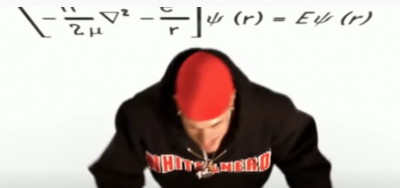 |
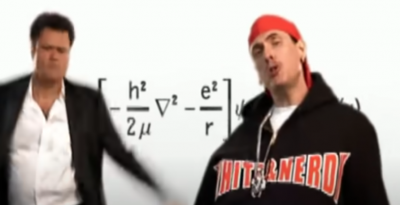
|
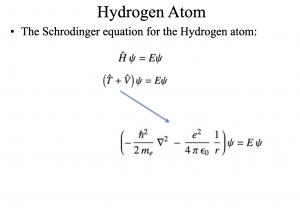 |
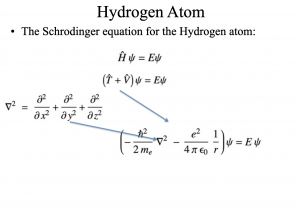 |
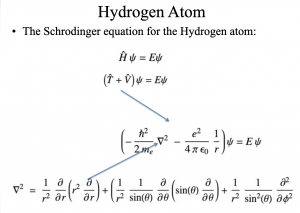
|
Comments/Corrections/Edits
- 1) As you can see in the Hydrogen Atom Schrodinger Equation on the bottom-left, the typical eq has the mass of the electron (me) as opposed to the reduced mass (μ). Technically this is not incorrect, if the reduced mass is for the nucleus and the electron...the reduced mass of nuc/e- = me. It is best to be written as me not μ.
- 2) It was a smart to use the "del" symbol (i cannot find this character- upside down Δ) to represent the 3D coordinates. As you can see in the middle, the del is shown in cartesian coordinates, but more useful form in QM for atoms are the spherical polar coordinates (right). It would have been very easy to make a typo is writing out either out the del.
- 3) Now onto the potential energy term...they are missing the 4πεo.
- 4) I would prefer if the wavefunction was written with all variable, R, Θ, Φ as opposed to just R...
- 5)...and one more...do you see it?...h-bar not h!
Sec 9.5 Radial Probability Distribution Function
At this point you should be fully aware of the mathematical form of the hydrogen atom wavefunctions (see pages 170-171). It has taken us some time to develop these wavefunctions/eignefunction/orbitals, but we are not yet done. The following discussion is referred to as the "real estate" problem. I looked on YouTube for a video to help explain this concept, but i failed to find one that was satisfactory...i guess i might need to make one of these...later.
In all of the previous QM model systems, there was an equal amount of "space" were the particle could exist...what i mean is...think about the particle-in-a-box...there is an equal amount of space on the left side of the box as there is in the middle or right side. Now with a spherical space, there is a lot more space available the further you move out from the center. If you look at the 1s wavefunction (Fig 9.6) or the 1s2 wavefunction (Figure 9.9), you will see that the probability of being at the nucleus is very high...but...how much "space" is available to this electron...because the area available to the electron at the nucleus is very small, then we must modify the wavefunction to incorporate this issue.
So, the radial function, R(r) is squared to become the radial probability function, R(r)2, which when you take into account the "space/distribution" problem...we now have the radial probability distribution function, r2 R(r)2.
- R(r) --> R(r)2 --> r2 R(r)2.
Yes, it is rather simple...just multiple the radial probability function by r2...see these plots in Figure 9.10. STUDY this figure...notice:
- 1) the probability of finding the electron at the nucleus is zero.
- 2) the r2 1s2, what we now referred to as the 1s-orbital, has a maximum probability of ao, the Bohr radius (5.29e-11m or 0.529 angstrom).
- 3) the 2s-orbital has a near-zero probability at ~2 ao...this is called a node. If you were to plot this in 3D spherical polar coordinate, there would be a node inside of the "sphere" that you could not see in that representation. The 1s-orbital would not have any nodes.
- 4) Notice the maximum probability for the 2-p orbital is inside of the 2-s orbital...meaning that a 2s electron is slightly further out from the nucleus than the 2p electron...there are arrows on top of the figure indicating the max prob for each orbital...3d is inside the 3p, which is inside the 3s.
- 5) keep studying this figure...it is one of the most important figures in all of chemistry-related QM!
One last thing
- So when we talk about/draw orbitals we show a hard surface...a sphere or a dumbbell shape. Q: What dictates the distance the hard surface is from the nucleus? A: Choose the 90% probability surface...ie. 90% of the time, the electron will be inside of the hard surface. This is of course a "weak" representation of the highly complex (and very attractive) orbital wavefunction, but when you are first taught about orbitals...you can't handle the "wavefunction" truth! <-- this phase is stolen from the movie...A Few Good Man